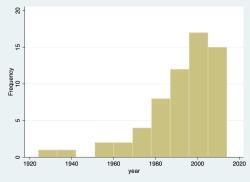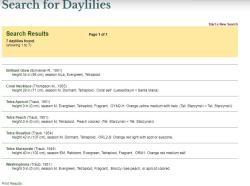Hazelcrestmikeb said:At the very least seedling pictures would suffice for me anyway. Sdlg X Sdlg sounds better than Ukn X Ukn.
RobLaffin said:WRT to "unknown" - if one of the parents is a cultivar that you know, but it is not registered with the AHS, the AHS requires you to list that parent as "unknown". So unknown does not necessarily mean unknown....
I don't know why people use "sdlg x sdlg" if they know the parents - it's just as easy to list "(cultivar A x cultivar B) x (cultivar C x cultivar D)" as the parents and gives buyers valuable info. Sometimes seedling markers get lost, in which case they're stuck with "sdlg x sdlg" but even there, it's helpful if the hybridizer will at least make an educated guess on their website - they often have a pretty good idea, but aren't totally sure and are honest enough not to register it using a questionable parent.
megdavis said:
In my scientific field, there are many unknowns. The fun bit is that there are "known unknowns" (where you have some information or know when you don't have information, both states apply to this discussion) and "unknown unknowns" (true unknowns, when you don't know that you don't know, and this does not apply here). The trick is how to share the "known unknown" information in a consistent way so everyone has equal access to what is known and what is not known. We actually have guidelines for how to do this for my scientific field (you literally have to follow them or you can't publish, which is the science project equivalent of registration).
Is there a push for more guidance related to registration of parentage? What are pros and cons to changes in guidance or standardization?
goedric said:
I have had this very discussion on more than one daylily group page on FB. To me any info is beneficial... I think just having specific entries for either of the known grand parents would be a first step. Also allowing SDLG as a suffix in the parent and grand parent fields would be useful... that way we would have tons more info in an economy of space.
As an alternative... an open ended field with "breeders notes" would be helpful
AND as an incentive.. they could charge more for Unknown x Unknown registrtions... that would discourage sloppiness, laziness and secretiveness...
megdavis said:
I love these ideas! I've been building my founder stock and doing a lot of reading on hybridizer websites to understand more about the cultivars, but I'm also a bit of a sentimentalist and have tried hard to include much older daylilies in my collection.
goedric said:True, but it is listed as hardy zones 4-9 on their website. Plus there is a thread here on dormancy. etc which discusses that fact that the generally accepted convention of using EV/SEV/DOR as a proxy for cold tolerance is no longer accurate with modern day hybrids... It's a great article written by Maurice that is well worth reading. In fact I need to read it again!
RobLaffin said:
Meghan - good that you are doing that. A number of big-name hybridizers, including Jamie Gossard and Curt Hanson, have said that many older cultivars have not been fully explored for their potential. Sometimes it's worth it to make crosses with them that nobody else has made and see what you get. Some of the oldies have really good, solid genetics for certain traits, so you might get a pleasant surprise if you use ones that do especially well for you. And you can take them in a new direction crossing with the newer intros that are now available. You might at least be able to work some good traits into your program.


JamesT said:
The AHS database has too many instances of pedigrees which were arbitrarily shortened for publication, presumably by the registrar, which makes me wonder just what the registration process is supposed to accomplish. Is its purpose to classify and record the history of the daylily's evolution? Or, is it simply a way to extract a fee for the privilege of participating in the daylily marketing game?
It's hard to say what drives the registration system. For instance, there have been rules in place for several years stipulating that a picture be submitted as part of the registration process, yet somehow there are still many entries which lack an image. Is this because the AHS is more interested in the $25 than the system which they have set up?
sooby said:It wasn't all that long ago that images started to be required for registration and AHS is trying to obtain as many images for daylilies registered before that time as possible.
goedric said:As an alternative... an open ended field with "breeders notes" would be helpful
AND as an incentive.. they could charge more for Unknown x Unknown registrtions... that would discourage sloppiness, laziness and secretiveness.